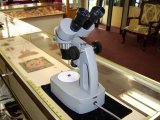
Does this instrument look familiar? No need for an introduction here! Stereoscopic binocular microscopes are a very useful investment in gem identification. And, they reveal a LOT of interesting features in diamonds and colored stones. Unlike a loupe, it's relatively handsfree to use. The range on this scope is from the standard 10x magnification to 120 power. When the magnification is increased the field of view decreases and illumination has to be increased. Microscopic examination of the unknown red cabochon reveals "silk," which is characteristic of corundum. Corumdum is the "family" name for rubies and sapphires. Since this "cab" has shown all of the correct parameters for the red variety of corundum, it is what it is. A natural untreated ruby cabochon. Gem identification doesn't necessarily include all of the tests that have been shown here. Some tests such as polariscopy and refractometry are mandatory in most cases. Some identifications require spectroscopy to seperate natural from synthetic or laboratory created gems. If you think this kind of work is "fun" you are correct. I am always looking at new gemstones. And, guess what? No two are ever exactly alike in every respect. Talk about variety!
 Does this instrument look familiar? No need for an introduction here! Stereoscopic binocular microscopes are a very useful investment in gem identification. And, they reveal a LOT of interesting features in diamonds and colored stones. Unlike a loupe, it's relatively handsfree to use. The range on this scope is from the standard 10x magnification to 120 power. When the magnification is increased the field of view decreases and illumination has to be increased. Microscopic examination of the unknown red cabochon reveals "silk," which is characteristic of corundum. Corumdum is the "family" name for rubies and sapphires. Since this "cab" has shown all of the correct parameters for the red variety of corundum, it is what it is. A natural untreated ruby cabochon. Gem identification doesn't necessarily include all of the tests that have been shown here. Some tests such as polariscopy and refractometry are mandatory in most cases. Some identifications require spectroscopy to seperate natural from synthetic or laboratory created gems. If you think this kind of work is "fun" you are correct. I am always looking at new gemstones. And, guess what? No two are ever exactly alike in every respect. Talk about variety!
Does this instrument look familiar? No need for an introduction here! Stereoscopic binocular microscopes are a very useful investment in gem identification. And, they reveal a LOT of interesting features in diamonds and colored stones. Unlike a loupe, it's relatively handsfree to use. The range on this scope is from the standard 10x magnification to 120 power. When the magnification is increased the field of view decreases and illumination has to be increased. Microscopic examination of the unknown red cabochon reveals "silk," which is characteristic of corundum. Corumdum is the "family" name for rubies and sapphires. Since this "cab" has shown all of the correct parameters for the red variety of corundum, it is what it is. A natural untreated ruby cabochon. Gem identification doesn't necessarily include all of the tests that have been shown here. Some tests such as polariscopy and refractometry are mandatory in most cases. Some identifications require spectroscopy to seperate natural from synthetic or laboratory created gems. If you think this kind of work is "fun" you are correct. I am always looking at new gemstones. And, guess what? No two are ever exactly alike in every respect. Talk about variety!

1 Comments:
Thank You for visting my blog.
Nice blog, though it not in my field of knowledge. Some nice documentation about jewellery.
Post a Comment
<< Home